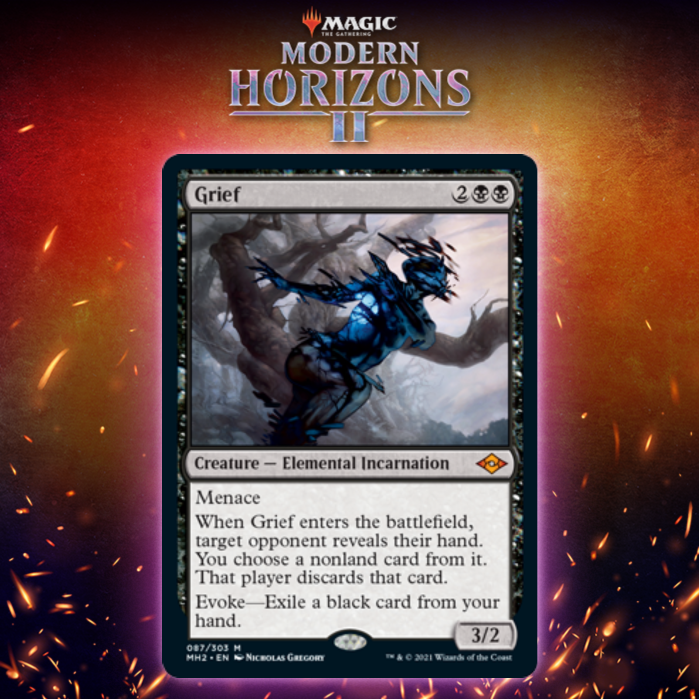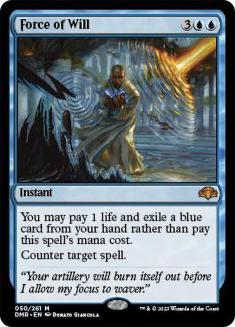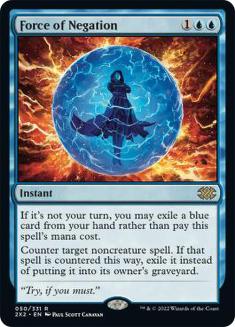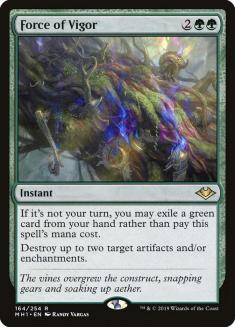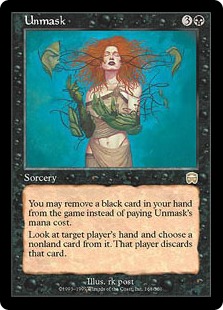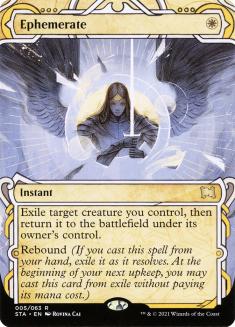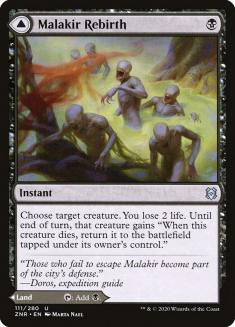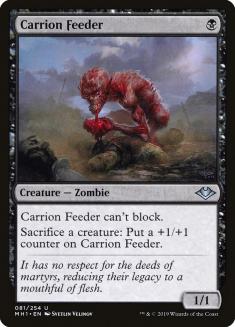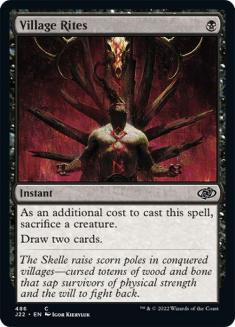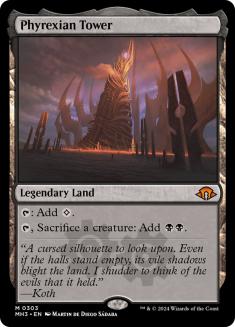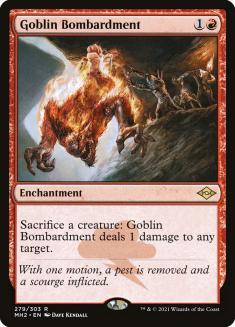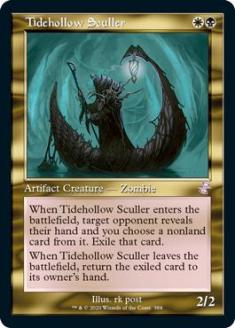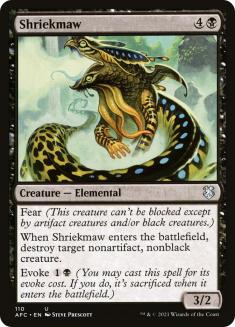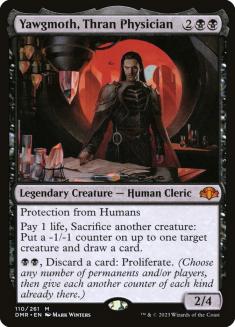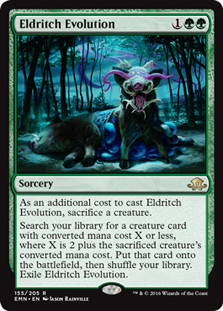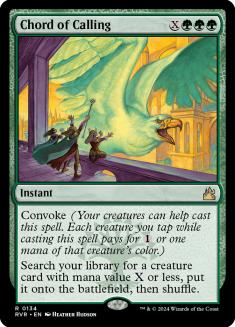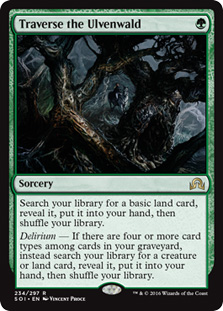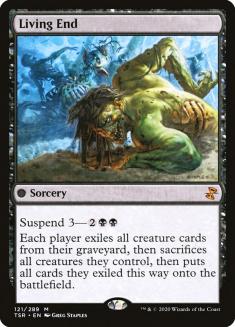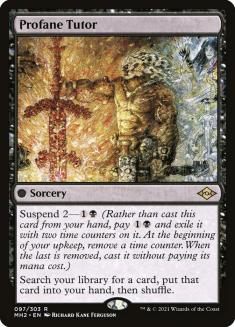Are we sure this is a good idea?!
We know Modern Horizons 2 will push the envelope. The only question is where. Grief is part of a cycle of ‘pitch’ creatures with a free evoke cost and, if this one is any indication, they’re priced to move. If Grief itself isn’t scary enough, consider that it may not even be the best card in its cycle!
If the history of Magic was somehow unclear about the danger of free spells, the history of Modern certainly isn’t.
The abundance of free effects in a format increases their individual importance. Lion’s Eye Diamond demands Force of Will; Diamond Lion does not. When every blue opponent has Force of Will, Force of Negation, and possibly Daze or Wasteland, one mana for interaction feels expensive and anything more than that is unaffordable. Legacy is kept in check by this uneasy balance of free and cheap spells that forces decks to flatten their curves.
This play pattern isn’t inherently desirable or transferable to other formats, which is why Force of Negation in particular has felt so out of place to many players with a long history in Modern. Force of Vigor’s main role was helping the most egregious free spell in Hogaak, Arisen Necropolis plow through a free answer in Leyline of the Void. The Modern banned list is littered with other free spells like Blazing Shoal or Once Upon a Time that quickly wore out their welcome, and known offenders like Chrome Mox or Dread Return that were never invited in.
The natural comparison for any old-timers is Unmask, usually seen clearing the path for fast kills in Legacy or setting them up by targeting yourself, discarding your own Griselbrand. Without both of these use cases, Unmask is a marginal card and I expect it wouldn’t make waves in Modern either. Is putting that effect on a creature really that much better?
The answer is an absolute, unequivocal yes. As we’ll see, all the best ways to exploit Grief rely on its type line aided by some templating quirks. Notably, casting a creature for its evoke cost results in a trigger being created when it enters the battlefield:
When this permanent enters the battlefield, if its evoke cost was paid, its controller sacrifices it.
This leaves a short window where the creature is on the battlefield while this trigger is on the stack, giving you a body to sacrifice or a chance to keep your creature around permanently with instant-speed blink effects:
This is the flashiest combo to emerge from Modern Horizons 2 so far and sets the bar high for other contenders.
- Turn 1: Exile a black card to evoke Grief. Resolve the discard trigger. Ephemerate with the sacrifice trigger on the stack, and get a second discard trigger as well as a Grief that sticks around.
- Turn 2: Ephemerate rebounds, targeting Grief for a third discard trigger.
By the beginning of your second turn, you have stripped the three best cards from the opponent’s hand and deployed a reasonable threat. The old maxim that you can’t Thoughtseize the top of your opponent’s deck highlights the importance of backing up disruption with pressure; Grief offers both in one card and is a much better draw than other discard if the game does devolve into a topdeck war.
If you’re on the play, you’re all but guaranteed to get this first pair of Grief triggers and these can take a removal spell to ensure you get to rebound Ephemerate. Even if the opponent is on the play, they need two one-mana removal spells to break this up! Grief’s discard and evoke triggers try to join the stack at the same time, but you control them both, so you choose their order and can have the discard trigger resolve first. If the opponent uses their one Lightning Bolt in response, you can just Ephemerate then. If they hold it, you can discard it and then Ephemerate in response to the sacrifice trigger. This trick also stops a single copy of Force of Negation from tagging Ephemerate. Players who aren’t familiar with this timing will go through all the stages of grief at once as they learn a vital lesson.
Tripling down on Grief is exceptional against any deck that cares about assembling their namesake combo or a web of synergies but the magnitude of this effect also crushes decks that focus on card quantity over quality or shield themselves from singular discard via redundancy — Burn can’t count to twenty when it’s down three cards. Against generic midrange or control decks that don’t rely on card quality or quantity, discarding three cards of your choice lets you create a specific weakness in their hand based on the remainder of yours.
The biggest obstacle for this interaction is finding a suitable home. Consider the Orzhov Blink deck that has put up occasional results in the final days of Strixhaven Modern:
Creatures (35)
- 4 Flickerwisp
- 4 Tidehollow Sculler
- 4 Stoneforge Mystic
- 3 Wall of Omens
- 4 Wasteland Strangler
- 4 Giver of Runes
- 4 Charming Prince
- 4 Skyclave Apparition
- 4 Elite Spellbinder
Lands (30)
Spells (15)

This list has very few black cards for an 60-card deck, let alone an 80-card one, and that’s before you remember that Wasteland Strangler doesn’t count (there are 59 non-evergreen mechanics in Modern Horizons 2 and I doubt anyone wants devoid to be one of them). There aren’t enough good black blink targets to reach a reliable total for Grief while supporting cards like Charming Prince, and Aether Vial taxes the same resource (raw card count) while pushing you in a different direction.
Supporting Grief + Ephemerate requires building a deck from the ground up:
Creatures (24)
- 4 Carrion Feeder
- 4 Shriekmaw
- 4 Tidehollow Sculler
- 4 Geralf's Messenger
- 4 Yawgmoth, Thran Physician
- 4 Grief
Lands (21)
Spells (15)

The Undying Evil / Supernatural Stamina class of cards are situationally powerful but tough to justify spending deck space on normally. Grief is a strong incentive to consider them, but they compete with Ephemerate in these colours and there are diminishing returns on those effects.
Putting that effect on a DFC fixes all these problems and increases the density of black cards in your deck, letting you pitch a redundant copy and not feel priced into pitching a more useful black card.
Grief gives you a free activation of Carrion Feeder or Yawgmoth, Thran Physician while making it easier to commit to them. A Turn 1 Carrion Feeder gets out of control remarkably quickly here. Village Rites is another one-mana payoff that makes up for losing a card to cast Grief on the cheap.
It’s entirely possible that the best sacrifice outlet is yet to come. Will we see another flashy new card or familiar favourite making its Modern debut?
Tidehollow Sculler offers a form of redundancy for Grief that works with these same effects. Unlike more recent discard creatures like Kitesail Freebooter, you can use similar stack tricks to blink or sacrifice Sculler before it takes a card in order to get rid of that card permanently.
Shriekmaw is a second high-impact evoke creature that covers you against threats on the battlefield in a way Grief can’t.
If the white card in the Grief cycle is strong enough, leaning harder on those interactions may be promising. For now, giving up Ephemerate lets us explore other colour pairs:
Creatures (19)
Lands (21)
Spells (20)

The multicoloured cards in Rakdos are a big draw to these colours for a normal midrange deck. Here they steal the show. Between these, Grief, and Thoughtseize you can shred the opponent’s hand reliably. Kroxa, Titan of Death’s Hunger is a resilient finisher that ends the game before they can recover. It also pairs well with Village Rites. Grief also gives Kolaghan’s Command a free, self-sacrificing creature to return when other modes aren’t relevant.
The Yawgmoth, Thran Physician deck that already exists in Modern couldn’t ask for a better card than Grief. Golgari Yawgmoth can’t afford to play much interaction and wants that to be stapled to a creature if possible. Against another combo deck poised to go off, that Eldritch Evolution might want to find Grief itself (and, when you have to play a scrappy beatdown game, hardcasting Grief is a fine play).
Going off can involve exposing Yawgmoth to removal or Eldritch Evolution to counters (including literal Counterspell now). Grief can clear the way on your combo turn with no prior warning. If you don’t have multiple undying creatures already, this is likely to be the ‘short combo’ turn that Ari describes in his article where you draw some cards and shoot down opposing creatures but can’t finish the job immediately. Grief neuters the danger in passing the turn back while giving you a free Yawgmoth activation (which can reset an undying creature for yet another activation).
It can even act as a Lotus Petal for Chord of Calling!
- Turn 1: Young Wolf.
- Turn 2: Wall of Roots.
- Turn 3: Exile a black card to evoke Grief. After the discard trigger has resolved, convoke Grief + Wall + Wolf and use your three lands with a green mana from Wall to cast Chord (X = 4) finding Yawgmoth. With the sacrifice trigger for evoke on the stack, sacrifice Young Wolf to Yawgmoth and then sacrifice Grief to Yawgmoth to reset Young Wolf.
Another obvious use for Grief will horrify anyone who lived through Hogaak’s reign of terror:
Creatures (34)
- 4 Carrion Feeder
- 2 Bloodghast
- 4 Hedron Crab
- 4 Vengevine
- 4 Gravecrawler
- 4 Lotleth Troll
- 4 Prized Amalgam
- 4 Stitcher's Supplier
- 4 Grief
Lands (22)
Spells (4)

We know that black has a strong emphasis on discarding your own cards in this set and one pushed enabler may be all we need to replace Faithless Looting. The other setup cards from the Hogaak deck are ready and waiting to make a comeback. If the green evoke creature is also strong, it quickly becomes trivial to return Vengevine from your graveyard as soon as it gets there.
Where the previous decks tried to lean into Grief synergies and a general focus on interaction, Grief fills a unique role here because these shells can’t run much interaction and have to hope that flooding the battlefield is enough. Buying an extra turn by taking their most important card can steal lost games.
Delirium is the Izzet mechanic for this set and the blue or red evoke creatures could help there but Grief might revive Modern’s most successful delirium card.
Creatures (17)
Lands (18)
Spells (25)

Grief makes it much easier to achieve delirium early and adds a unique functionality to Traverse the Ulvenwald, turning it into yet another one-mana discard spell in a pinch.
Traditional Jund or Golgari Midrange will probably try Grief to some success, but it’s a more natural fit in a deck with a curve this lean. The comparative advantage of Death’s Shadow decks in Modern is that you operate much better in a ‘smaller’ game than the average deck. If both players have fewer cards, Shadow is more likely to draw spells, be able to cast those spells, and have its cheap threats dominate the battlefield while ending the game before it can ‘grow.’
Grief contributes to that goal as the most efficient way possible of trading resources and protecting Death’s Shadow or Tarmogoyf. A deck with more spells naturally has more Grief fodder and the black interaction tends to be polarized in its effectiveness both across matchups and within games; other discard spells become dead draws later on and Fatal Push is either your best card or your worst. You’re likely to have a blank card to feed Grief and this makes spending two cards to take one easier to stomach.
Another Modern classic is automatically interested in creatures that can put themselves in the graveyard while doing something else:
Creatures (25)
- 4 Street Wraith
- 3 Shriekmaw
- 4 Architects of Will
- 4 Curator of Mysteries
- 4 Horror of the Broken Lands
- 2 Striped Riverwinder
- 4 Grief
Lands (18)
Spells (17)

Living End has seen a renaissance recently in Modern with a blue-heavy twist on the cascade shell building around Violent Outburst and Ardent Plea. This spin pivots hard into black for Grief and revisits the As Foretold engine that was briefly popular with Living End a few years ago for another Modern Horizons 2 pickup in Profane Tutor, which can find As Foretold or be cast for free with it to find the missing Living End.
Once again, this may just be the tip of the iceberg. Any new cards like Profane Tutor that share Living End’s template are options for the As Foretold + Electrodominance family of combo decks. A three-mana cascade card would give classic Living End a critical boost in consistency. The other members of the Grief cycle — especially the blue one — make a turbo-Living End plan much more realistic.
Grief is the perfect introduction for this preview season. It’s a groundbreaking new card that offers a flavourful and terrifying omen of what may come.

